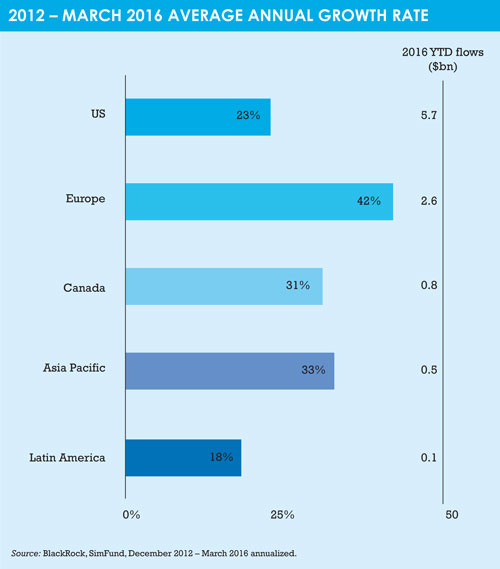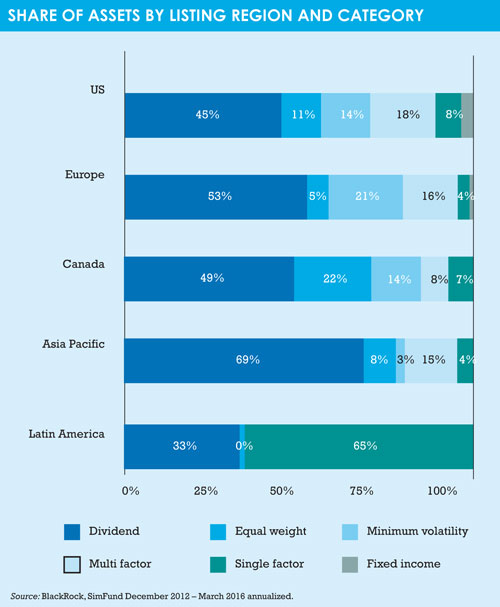Manuela Sperandeo tells Funds Europe why the rationale for smart beta investing is as strong as ever and is here to stay.
The name may be new but the concept behind smart beta has been around for some time. But as the battle between passive and active investment has become more pronounced in recent years, fund providers have spent more time developing smart beta products as a way to bridge the gap between the two ends of the investment spectrum.
Blackrock’s global range of smart beta products goes back more than five years, although it could be argued that some of the dividend strategies so popular in the 1980s were the first generation of smart beta strategies.
The concept behind BlackRock’s smart beta range, the ETFs especially, is to offer investors access to factor-based investing in an affordable and index-based way. “It is all about giving access to these time-tested drivers of returns,” says Manuela Sperandeo, Emea head of specialist sales at iShares, BlackRock’s ETF business.
 There is a clear attraction to smart beta for investors, says Sperandeo – improved portfolio outcomes, reasonable pricing compared to active management and transparent rules around security selection, portfolio construction and rebalancing. Fortunately, the fact that the products are index-based makes it easy for investors to adopt them within their existing asset allocation frameworks. Furthermore, the underlying indices are becoming increasingly transparent, says Sperandeo. “The index rules are easily available and they make it clear how these products work and what the engines powering them are.”
There is a clear attraction to smart beta for investors, says Sperandeo – improved portfolio outcomes, reasonable pricing compared to active management and transparent rules around security selection, portfolio construction and rebalancing. Fortunately, the fact that the products are index-based makes it easy for investors to adopt them within their existing asset allocation frameworks. Furthermore, the underlying indices are becoming increasingly transparent, says Sperandeo. “The index rules are easily available and they make it clear how these products work and what the engines powering them are.”
So far, smart beta products have been concentrated on equities, offering a middle ground between index-based beta investment and active alpha-based investing. The rationale that spurred investors to embrace smart beta has remained the same in the last five or so years. And if anything, that rationale has grown stronger thanks to technology, says Sperandeo.
“Technology has been a big driver. It has given fund manufacturers and also investors the ability to evaluate and capture efficiently a huge amount of data around companies’ balance sheets and stock prices. The kind of data that was difficult to get hold of in the past is now easily accessible to index providers who can then design products aimed at reflecting the systematic elements of particular investment styles or strategies.
“While capitalisation weighted indexes aim to represent the broad market beta, additional sources of systematic return associated with particular investment styles and strategies, such as value, momentum and low volatility, could be represented through these alternatively weighted indexes.
EMPOWERED
“Also for investors, the access to data has widened so they are empowered to measure the benefit of smart beta and to scrutinise the performance of active managers against these, identifying those that are able to generate return above and beyond what can be acquired efficiently and at a low price via a smart beta ETF,” says Sperandeo.
Sperandeo also believes that smart beta is here to stay, not least because these strategies, though still recently launched, have been around long enough to demonstrate their advantages. “The main smart beta providers have been in the market long enough to have a track record and to show what these strategies can deliver in terms of performance and outcome. We have a few products that have been trading live with real money for over three years now, not to mention the first dividend strategy which was launched in the US as an ETF in 2003.”
Another trend that is likely to increase the longevity of smart beta products is the increasing pressure on fees, which has helped index-based investments gathering a tremendous volume of assets over the last decade as investors shift portfolios to more cost-effective structures. Smart beta strategies allow investors to seek enhanced risk-adjusted returns at a lower cost than active strategies while retaining many of the benefits of investing in traditional index strategies.
If there is a danger to the long-term attractiveness of smart beta products it is that they might be seen as a panacea. They are not, says Sperandeo. “There are different factors which all have different drivers for performance. They will not provide returns in all conditions on their own. So investors have to bear in mind the cyclicality of the different factors and aim for long-term returns.”
EDUCATION
With this in mind, fund providers and promoters have embarked on an education campaign to raise investors’ awareness of the machinations of factor investing and smart beta, says Sperandeo. “Before it used to be all about the product but now there is much more awareness. We have made a greater effort to explain the key drivers of risk and returns of smart beta strategies and the need to keep a long-term approach when investing in these products. I feel we are in a much better place because of this.”
But in order to maintain their longevity, will smart beta products have to attract a wider range of investors as opposed to the sophisticated, professional investors and wealth managers that make up the majority of the investor base at present?
Sperandeo draws parallels with the rise of ETFs that have found a much wider audience after originally appealing to a niche portion of investors. “ETFs used to be the realm of professional investors looking to use them to make specific asset allocation calls but they have now become a broader investment tool. It is the same with smart beta. It used to be the preserve of very sophisticated investors but they are now being used by a broader audience of wealth and institutional investors.”
The compression of fees in the pension space has been a big help in pushing investors to index-based solutions and is now pointing them to smart beta as a potential way to generate return in excess of market-cap weighted benchmarks. Similarly, the big trend toward fee-based distribution models is positioning smart beta, and factor investing more broadly, as an alternative to expensive active management and a real differentiator in the wealth management offering.
 As the investor base broadens, it is likely that different wrappers – segregated mandates, mutual funds and ETFs – will appeal to the different investor types, says Sperandeo. For those investors that have put factor strategies at the core of their portfolio and are less concerned about tradeability, segregated mandates and mutual funds could be more attractive. In contrast, those investors that want to use smart beta as a tactical tool will likely opt for ETFs which are more easily tradeable.
As the investor base broadens, it is likely that different wrappers – segregated mandates, mutual funds and ETFs – will appeal to the different investor types, says Sperandeo. For those investors that have put factor strategies at the core of their portfolio and are less concerned about tradeability, segregated mandates and mutual funds could be more attractive. In contrast, those investors that want to use smart beta as a tactical tool will likely opt for ETFs which are more easily tradeable.
Smart beta has also been the way for new players to enter the ETF space, with increasing proliferation of products (with more than 800 smart beta ETFs available to investors globally) and increasing pressure on fees. This raises the question of just how long all the existing products can survive.
However, it is still early days for the smart beta market and while some will inevitably be closed down if they fail to attract enough investors and are too similar to other larger products, providers will be reticent to take such a step.
COMMITMENT
For the smart beta providers in the market, the main objective is to demonstrate their commitment to the market, says Sperandeo. In June 2015, BlackRock appointed former Columbia Business School professor Dr Andrew Ang to lead the company’s factor-based strategies group. It is an appointment that Sperandeo says underlines BlackRock’s view that factor-based investing will be a key driver to shape the future of the investment industry.
Innovation will be a pre-requisite for any firm looking to be successful in the smart beta and factor investing market. Most of the innovation recently has centred on multi-factor equity products and ensuring that investors have a clear understanding of how the strategy works and the benefits of combining the different factors.
Future innovation is likely to focus on applying these concepts to other asset classes beyond equities, says Sperandeo – fixed income, for example, although it presents challenges in terms of liquidity and execution, or commodities, where quantitative investment strategies have been around for some time, but not adopted by the broader investor audience just yet.
There is also a burgeoning interest in developing multi-asset and market neutral, multi-factor products that are able to capture the interesting correlation patterns of risk premia across different asset classes, says Sperandeo.
But is there a danger that, as the marketplace becomes more crowded and providers seek to be innovative to stand out from their competitors, some products become too complex, too obscure and fail to gain investors’ interest?
“We concentrate on those factors that are here to stay and are based on economic fundamentals,” says Sperandeo. “And while the smart beta market may be growing, it is still only a fraction of the size of the broader equity investment market, so there is still potential for further growth in this space.”
©2016 funds europe





